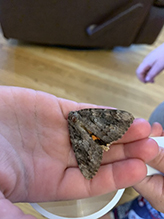pink underwing
(Catocala concumbens)
Conservation • Description • Habitat • Ecology • Distribution • Taxonomy
|
|
||||||||||||||||||
Description |
Pink underwing is a medium to large sized, strikingly colored, underwing moth. Adults are 1¼″ to 1½″ in length and have a wingspan of 2⅜″ to 3″. The forewings are light gray and brownish gray with thin, black, jagged, antemedial and postmedial lines. The kidney-shaped (reniform) spot is slightly paler than the surrounding background color. The hindwings are pink with a black median band, a black terminal band, and a wide, straight, uninterrupted, white fringe. The antennae are slender and thread-like. There is a prominent tympanal hearing organ on each side of the thorax. |
Size |
Wingspan: 2⅜″ to 3″ Total length: 1¼″ to 1½″ |
Similar Species |
Darling underwing (Catocala cara) forewings are darker grayish-brown and violet-brown. The fringe on the hindwing is undulating or checkered. Once-married underwing (Catocala unijuga) forewing reniform spot is dark and there is a whitish spot in front of it. The subterminal jagged line has a broad, whitish outline in front. The fringe on the hindwing is undulating. |
Habitat |
Shrubby riverbanks, woodland edges, urban plantings. |
Ecology |
Season |
One generation. August to early September. |
Behavior |
Larvae are solitary feeders. Adults are active at night. They are attracted to light. When at rest the wings are folded roof-like over the body. When approached or disturbed they spread their forewings revealing the startling color of the hindwings, possibly to scare off or give it time to escape a predator. |
Life Cycle |
Eggs overwinter. |
Larva Hosts |
Leaves of poplar (Populus spp.) and willow (Salix spp.). |
Adult Food |
|
Distribution |
||
|
Sources 21, 24, 27, 29, 30, 71, 75, 82, 83. Biodiversity occurrence data published by: Minnesota Biodiversity Atlas (accessed through the Minnesota Biodiversity Atlas Portal, bellatlas.umn.edu, 7/11/2025). |
|
| 7/11/2025 | ||
Occurrence |
||
Common |
||
Taxonomy |
|
Order |
|
Superfamily |
Noctuoidea (Owlet Moths and Allies) |
Family |
Erebidae (Underwing, Tiger, Tussock, and Allied Moths) |
Subfamily |
Erebinae (underwings, zales, and related owlets) |
Tribe |
Catocalini |
Genus |
Catocala (underwing moths) |
Subordinate Taxa |
|
|
|
Synonyms |
|
Catocala diana Catocala hillii |
|
Common Names |
|
pink underwing sleepy underwing sleepy underwing moth |
|
Glossary
Reniform spot
A kidney-shaped spot or outline in the lower median area near the PM line on the forewing of many moths.
Visitor Photos |
||
Share your photo of this insect. |
||
This button not working for you? |
||
Nicole Rojas-Oltmanns |
 |
Rescued from a gas station and brought to the adjacent woods in my hands. Showed its colors after I set it down. |
Hannah and Grace Gold |
 |
Nan Throlson |
 |
Bill Reynolds |
||
Pink Underwing (Catocala concumbens) on a 1/4 hardware cloth screen. |
||
 |
 |
|
 |
||
MinnesotaSeasons.com Photos |
||
|
||
|

Slideshows |
|

Visitor Videos |
||
Share your video of this insect. |
||
This button not working for you? |
||
|
Other Videos |
||
Pink Underwing Moth (Noctuidae: Catocala concumbens) in Grass |
About
Uploaded on Sep 13, 2011 Photographed at Grand Forks, North Dakota (13 September 2011). Thank you to Marcel Such (@Bugguide.net) for confirming the identity of this specimen! |

Visitor Sightings |
||
Report a sighting of this insect. |
||
This button not working for you? |
||
Edward Peck |
Location: Springfield, VT |
|
| Celeste 10/2/2022 |
Location: Duluth, MN Found on some raked crabapple piles and up in the Dolga Crabapple tree. |
|
| Prudy Reberg 9/11/2022 |
Location: Rice Minnesota 2:30 pm sitting on our porch a gigantic gray moth landed near us, I approached to get a photo of it and that’s when it flew around us and landed on the ceiling fan, we saw the beautiful underwing colors. Then it flew away before we could capture a photo. |
|
| Barbara 8/16/2020 |
Location: Shoreview, MN The underwing I saw had orange in place of the pink markings. The underwing was on my coleus plant on the deck. The orange and black markings were a zig zag pattern. She opened her wings once and I was thrilled to see the colorful markings. I found the name of this species by pure luck. The internet did not readily have photos of this moth and it’s markings. |
|
| John Valo 8/17/2020 |
There are at least 27 similar underwing moths in eastern North America, 21 of which occur in Minnesota. About half of these have pink or red on the hindwing, half have orange or orangish-yellow. Your underwing was likely one of the latter. |
|
A K |
Location: Shoreview, MN |
anonymous |
Location: Kerrick, MN |
| Hannah and Grace Gold 9/14/2019 |
Location: south Minneapolis |
 |
| Nan Throlson 8/12/2019 |
Location: St. Wendel, Stearns County |
 |
| Bill Reynolds 9/29/2016 |
Location: Pennington Co., MN Pink Underwing (Catocala concumbens) on a 1/4 hardware cloth screen. |
 |
MinnesotaSeasons.com Sightings |
||
|

Created 10/1/2016 Last Updated: © MinnesotaSeasons.com. All rights reserved. |
